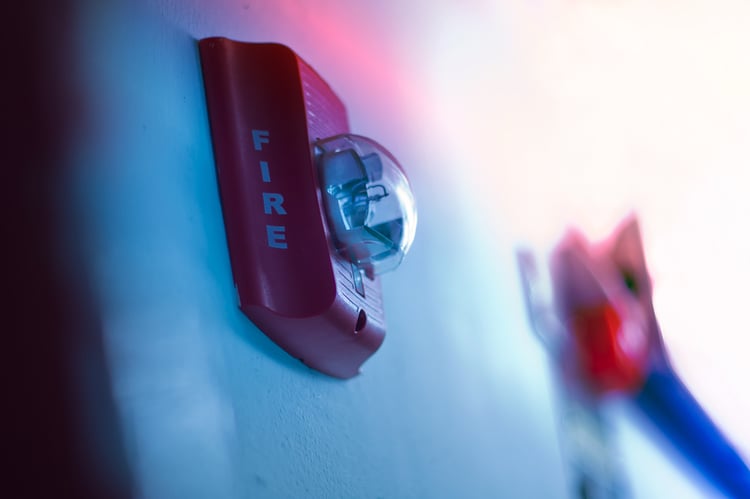Occupancy classifications indicate the approved use of built spaces. The characteristics of indoor environments and the activities carried out have a major impact on the characteristics of a fire that may occur and therefore also determine which fire alarm system design is suitable.
Buildings, or parts thereof, should be classified in the occupancy group they most closely resemble, considering fire safety and the relative risk involved. Additionally, approval from the FDNY Commissioner is required.
Get a professional fire alarm design for your building.
Let us help you
Occupancy groups where fire alarms are required
 Because fire alarms play a key role in alerting occupants when a fire occurs, they are necessary in a wide variety of built environments. The following table summarizes the requirements for each occupancy group:
Because fire alarms play a key role in alerting occupants when a fire occurs, they are necessary in a wide variety of built environments. The following table summarizes the requirements for each occupancy group:
|
OCCUPATION GROUP |
CONDITIONS FOR MANDATORY FIRE ALARMS |
|
Assembly group A |
Occupant load of at least 300 |
|
Business Group B |
Locations protected by an automatic sprinkler system, plus at least one of the following conditions: |
|
Educational |
All Group E occupations. |
|
Factory and Industrial Group F |
Occupancies of at least two floors, plus at least one of the following conditions: |
|
High risk |
Subgroup H-5, and all occupations used to manufacture organic coatings. |
|
Institutional |
All occupations in Group I. |
|
Mercantile |
Occupations that meet at least one of the following conditions: |
|
residential |
All subgroup R-1 occupancies unless they meet a series of fire protection measures and egress accessibility requirements detailed in Article 907.2.8 Subgroup R-2 occupations that meet one of the following conditions: |
The New York Building Code also establishes special fire alarm requirements for buildings that meet one of the following descriptions, regardless of occupancy classification:
- Skyscrapers
- Atriums that connect more than two floors
- Aerosol storage rooms and warehouses
- Sawmills and other wood processing applications
- Underground buildings
- Indoor mall buildings over 50,000 square feet.
This list is a general guide and should not be considered a substitute for the New York Building Code. Detailed requirements and exceptions apply in many cases and must be taken into consideration before designing and installing a fire alarm system. Consider that fire alarm systems must also meet NFPA 72 in addition to the New York Building Code.
Fire Alarm System: Device Requirements by Occupancy
 Just as the general requirement for installing fire alarms changes depending on occupancy, device requirements also vary. They are summarized in the following table:
Just as the general requirement for installing fire alarms changes depending on occupancy, device requirements also vary. They are summarized in the following table:
|
Occupation |
Covered areas |
Required devices |
|
Set |
Any number of occupants: civic or social functions, worship, recreation, food or beverage consumption, transportation waiting areas, or similar group activities. 75 people or more: educational or instructional purposes. |
– Manual drive station |
|
Business |
Office space, professional and service transactions, public or civic services, limited storage of records and accounts, and limited inventory of goods for office use. |
– Manual drive station |
|
Educational
|
Buildings intended for simultaneous use by at least five people, for educational purposes up to the 12th year and where there are no more than two children under 2 years old. |
– Manual drive station |
|
Factory and Industrial
|
Industrial activity with non-combustible materials, including cleaning, washing, manufacturing, manufacturing, finishing, packaging or processing, among others. |
– Manual drive station |
|
High risk |
Manufacturing, processing, generation or storage activities, with hazardous materials that pose a physical or health hazard in the quantities present. |
– Manual drive station |
|
Institutional
|
Supervised environments for people with physical limitations due to health reasons or advanced age, for care or treatment. It also includes facilities where people are detained for criminal or correctional purposes. |
– Manual drive station |
|
Mercantile
|
Spaces used to display and sell merchandise, which may include storage areas. |
– Notification devices |
|
residential
|
Buildings, or parts of buildings, used for living or sleeping, but not including occupancies classified as Group I. |
– Smoke detectors |
|
Store |
Warehouses, warehouses, cargo depots and distribution centers that are not classified in Group H. |
– Manual drive station |
|
Utility and Miscellaneous |
Accessory areas such as private garages, retaining walls, sheds and garages. |
– Manual drive station |
*The New York Building Code does not make fire alarms mandatory in these occupancy groups except in special cases, but there are still requirements to be met if the decision to install a fire alarm is made.
Final Recommendations
This article deals exclusively with requirements for fire alarm systems, but we consider that they exist only among many fire protection systems for buildings. Furthermore, these other systems may or may not be mandatory depending on the occupation classification, and there are also requirements that vary according to the occupation.
NYC has very strict fire protection standards, so the best recommendation is to seek professional engineering services from the beginning of the project. In the specific case of high-rise office buildings, it is very important to ensure that the property is fully sprinklered in accordance with Local Law 26 of 2004, the deadline for which is July 1, 2019.
Code references
- NFPA 72.
- New York Building Code Chapter 3.
- New York Building Code Chapter 9 Section BC 907

